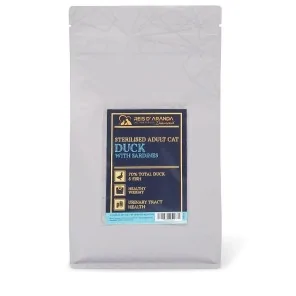Its name says it all: the Vienna blue rabbit comes from Austria. Not only is it beautiful with its shiny blue-grey...
WHAT SHOULD MY PET'S URINE BE LIKE?
INTRODUCTION
The urine of animals can have many colours and some of them, although scary, do not necessarily indicate anything bad; different urinary problems and even in other parts of the body, dehydration and taking medication can cause a change in the colour of the urine of our animal, and some of them are clear warning signs that have to make us act.
WHAT IS URINE MADE UP OF?
Under normal conditions, the urine of animals is mainly composed of:
- WATER: 95%.
- UREA: a chemical compound and waste substance that tells you a lot about the health of your kidneys and how well they are functioning.
- UREA NITROGEN: comes from the elimination of proteins and is contained in urea.
- SODIUM: most of the sodium taken in with food (about 90%) is excreted in the urine. Its values are measured to evaluate the amount of sodium introduced daily and the correct functioning of the kidneys.
- MINERAL SALTS: calcium, potassium and magnesium.
- URIC ACID: a waste substance of cellular metabolism.
URINE AS A SIGN OF OUR PET'S HEALTH
The colour, odour, density of urine and urination can tell us if there is some kind of health problem. Animals cannot tell us most of the time if something is bothering them except for the really obvious problems we will see below, so it is important that we do not overlook the following symptoms:
VERY DARK COLOURED URINE AND STRONG SMELL: This tells us that the animal is dehydrated and needs to drink a lot more water.
REDDISH COLOURED URINE: In rabbits the urine can be orange in colour if they have eaten food with this colouring (such as carrots) but reddish coloured urine can also indicate the presence of blood. If we see this colouring in our pet's urine, the best thing to do is to pour (if possible) hydrogen peroxide over the urine. If it bubbles, there is blood and we should go to the vet as it may indicate the presence of crystals in the urine, kidney stones, advanced infections, rupture of red blood cells or renal insufficiency.
DIFFICULTY TO URINATE: If our pet finds it difficult to urinate, it may be a case of kidney stones or crystals.
PAIN WHEN URINATING: As in the previous point, we may be dealing with a case of kidney stones or crystals, or even foreign masses that may hinder the correct passage of urine.
EXCESSIVE URINE: If our pet drinks excessively and urinates almost immediately, in very large quantities, we may be dealing with a diabetic animal.
VERY BAD SMELLING URINE ACCOMPANIED WITH VOMIT: This indicates possible liver damage.
NORMAL QUANTITY OF URINE BUT TOO CLEAR: This may indicate a problem at the renal level, as the kidneys are not filtering correctly.
DISEASES RELATED TO THE URINARY SYSTEM
RENAL INSUFFICIENCY: Acute renal failure is the sudden loss of kidney function, which can be caused by a number of factors, including decreased blood pressure, toxins such as antifreeze, urethral or urethral obstructions, and diseases, such as leptospirosis and Lyme disease. If diagnosed early and treated aggressively, acute renal failure may be reversible. Chronic kidney failure is long-term loss of kidney function that cannot be reversed, but treatment can help slow the progression of the disease.
STONES / RENAL CALCULUS: Dogs can form mineral crystals and stones, anywhere in the urinary tract. These crystals and stones can irritate the lining of the urinary tract or block the flow of urine, which is a medical emergency.
URINARY INFECTIONS: Bacteria can ascend through the urethra or travel through the blood and infect the urinary bladder, prostate (especially in unneutered male dogs), and kidneys.
INCONTINENCE: This condition occurs most often in neutered bitches. Pets with this condition often lose bladder control while sleeping. Dogs with spinal cord disease or injury may also develop urinary incontinence.
PIELONOPHRITIS: This is a kidney infection caused by bacteria in the urine affecting the ureter. This disease usually occurs when there has been a previous bladder infection and can be acute or chronic.
NEPHRITIS: Nephritis is an inflammation that is related to diseases such as:
- Erlichiosis.
- Leptospirosis.
- Borreliosis.
- Pyelonephritis.
- Hepatitis.
- Pancreatitis
NEPHROSIS: It is the degeneration of the kidney and can occur due to lack of blood supply or ‘intoxication’ such as, for example, the consumption of certain medicines.
HEPATITIS: Hepatitis is inflammation of the liver. Inflammation is the swelling of organs that occurs when they become injured or infected, and can damage your liver. The swelling and damage can affect the proper functioning of this organ. Hepatitis can be an acute (short-term) infection or a chronic (long-term) infection. Some types of hepatitis cause only acute infections. Others can cause both acute and chronic infections.
PANCREATITIS: Pancreatitis is inflammation of the pancreas. It occurs when pancreatic enzymes, which digest food, are activated in the pancreas instead of in the small intestine. Inflammation can be sudden or progressive.
CHRONIC RENAL DISEASE (CKD): Chronic kidney disease (CKD) is characterised by the progressive loss of the kidneys' ability to filter blood and reabsorb water from urine. Metabolic waste products tend to accumulate in the body and even if the cat drinks more water than usual, it tends to become dehydrated. Chronic kidney disease (CKD) is not reversible, but recent tests make it possible to diagnose it earlier than before.
ENCEPHALITOZOON CUNICULI: This parasite (which has its own article on our blog) can affect the kidneys and cause incontinence in rabbits.
CRYSTALS IN THE URINE: Crystals in the urine are the formation and accumulation of small masses that are composed of phosphate, calcium and magnesium, for example. It is normal to present very small quantities of these crystals in the urine, which can occur due to eating habits, low water intake and changes in body temperature. Some dog breeds such as the Dalmatian are prone to them; currently there are two lines of Dalmatians (HUA and LUA) created to minimise these cases, LUA Dalmatians do not usually accumulate crystals in the urine.
CANCER: These neoplasms are rare, accounting for less than 2% of tumours affecting dogs and less than 3% of those affecting cats. Their prognosis is generally very poor due to the invasive nature of the process and their tendency to metastasise rapidly.
CONCLUSION
As we can see, our pet's urine can tell us many things about his health, several of these pathologies are reversible or solvable in their early stages, so it is never too late to recognise the symptoms that something is wrong and go to the vet.
Leave a comment
Log in to post comments
















